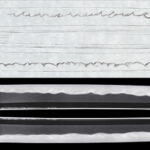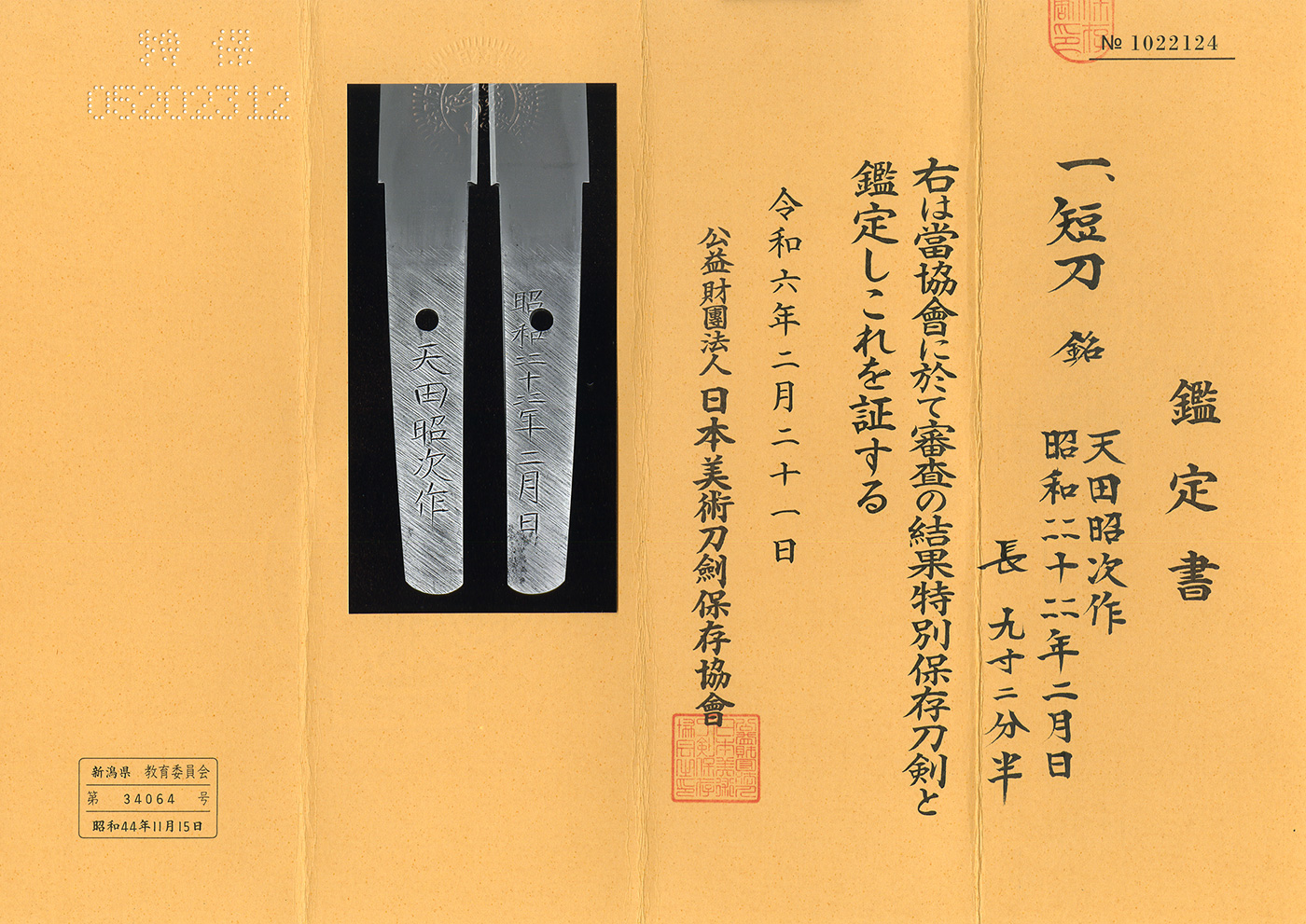Ordering number:23537
Tanto: in Shirasaya (NBTHK Tokubetsu Hozon Token)
Signature: Amada Akitsugu (Living National Treasure, Important Intangible Cultural Property)
Showa 44 Nen 2 Gatsu Hi (February 1969)
天田昭次作(人間国宝・無形文化財)
昭和四十四年二月日
We divide 4 sections for each sword as Saijyo Saku, Jyojyo Saku, Jyo Saku and Regular Saku.
This work is ranked as Saijyo Saku for Amada Akitsugu.
Polished.
Habaki: Gold-plated double habaki.
Blade Length: 28.1 cm (11.06 in)
Curvature: 0 cm (0 in)
Mekugi Hole: 1
Width at Base: 2.66 cm (1.05 in)
Width at Tip: 2.78 cm (1.09 in)
Thickness: 0.61 cm (0.24 in)
Sword Weight: 205 grams (7.23 oz)
Era: February 1969
Shape: The blade is wide with a thick kasane, maintaining a healthy condition with ubuha.
Jigane: Ko-itame mixed with mokume, creating a beautiful jigane with ji-nie.
Hamon: Starts with ko-gunome, resembling the style of Muramasa, with matching patterns on both sides. The boshi is rounded and returns in ko-maru.
Features: The hamon features ko-nie deki with gunome-midare, which becomes larger, with well-functioning ashi, a soft nioiguchi, and a rounded boshi. The blade shows activity such as sunagashi and kinsuji.
Aoi Art’s Comment: Amada Akitsugu, whose real name is Seiichi, was born as the eldest son of Amata Sadayoshi in Niigata Prefecture, known for its steel industry. He learned sword forging from his father. Akitsugu trained at the Japanese Sword Forging Training Center but had to cease swordmaking after World War II. After the war, in 1954, he was authorized to forge swords and won the Excellent Award at the first Sword Forging Technology Presentation. He subsequently won the Masamune Prize three times and dedicated swords to the Ise Shrine three times, becoming a Living National Treasure (Important Intangible Cultural Property) in 1997. His work includes various styles such as Bizen, Yamato, and Yamashiro traditions. He passed away in 2013 at the age of 85. Unlike Muramasa, whose hamon can become notable with flaws, this tanto is mostly pristine and of excellent quality. Highly recommended for collectors of important intangible cultural properties by a Living National Treasure.
NBTHK Tokubetsu Hozon Token
Aoi Art estimation paper
Whole Oshigata
Order Form
Related Items:
 Wakizashi (Sunnobi Tanto):Kaga-ju Ryosanshi Masamine Saku Kore ( Living National Treasure)(NBTHK Tokubetsu Hozon Token)
Wakizashi (Sunnobi Tanto):Kaga-ju Ryosanshi Masamine Saku Kore ( Living National Treasure)(NBTHK Tokubetsu Hozon Token)
 Tanto:Gassan Sadakatsu Kinsaku(Kao)(NBTHK Tokubetsu Hozon Token)
Tanto:Gassan Sadakatsu Kinsaku(Kao)(NBTHK Tokubetsu Hozon Token)
 Tanto:Sagami Kuni Hiroki Hirokuni (Mukansa Swordsmith) Heisei 22 Nen Yayoi
Tanto:Sagami Kuni Hiroki Hirokuni (Mukansa Swordsmith) Heisei 22 Nen Yayoi
 Tanto: Toshihira(Osumi Toshihira)(NBTHK Tokubetsu Hozon Token)
Tanto: Toshihira(Osumi Toshihira)(NBTHK Tokubetsu Hozon Token)
 Wakizashi(long Tanto): Yamaguchi Kiyofusa, 1989
Wakizashi(long Tanto): Yamaguchi Kiyofusa, 1989
 Tanto:Oite Tokyo Uzawa Oumi Suke Minamoto Taneaki Saku(NBTHK Tokubetsu Hozon Token)
Tanto:Oite Tokyo Uzawa Oumi Suke Minamoto Taneaki Saku(NBTHK Tokubetsu Hozon Token)






